
CATER Mask
Decisions
December 14, 2020
Holistic and Timely Use of
Filtration Resources Needed to
Fight COVID
Face Masks will be the Focus on
Wednesday at the WFI Conference
Researchers at King Abdullah
University Develop Membrane for
Face Masks
TTG has Efficient Membrane Media
for Masks
ePTFE Membranes - Application in
High-End Face Masks
DHA Uses Same Media for Masks
and Gas Turbine Inlet Filters
TEFM Provides ePFTE Membranes
for Masks
Membranes for Mask Supplied by
Cobetter
BYU Develops Nanofiber Mask
Nanofiber Media Reduces Face
Mask Resistance
____________________________________________________________________________
Holistic and Timely Use of
Filtration Resources Needed to
Fight COVID
The filtration industry can save
hundreds of thousands of lives
in the next year regardless of
how fast vaccines can be
produced and delivered. More
efficient masks and air filters
are needed. Alternatives are not
nearly as effective because
·
Sanitation is proving to be a
minor solution because the virus
is airborne.
·
Social distancing is as
effective in avoiding virus as
it is avoiding perfume or
cigarette smoke.
·
Partitions cause turbulence and
can cause viruses to remain in
suspension but do not prevent
the small particles from easily
flowing around any structure.
·
Increasing the amount of outside
air flowing through a room is
hugely expensive as opposed to
filtration.
The challenge is to make
adequate numbers of efficient
masks and filters available now
but avoid the cost of
mothballing newly built
facilities when the vaccines
become effective.
There is a holistic approach
which will accomplish this goal.
All air filters are essentially
just filter media with a support
structure. Membranes can be used
in masks and in gas turbine
intake filters. There are very
specialized facilities to make
the media but a variety of
sources can be utilized to make
the structures,. Many of these
sources can add second shifts
and produce filter housings or
masks and then switch to some
other products.

The Mcilvaine forecast for the
2022 filter market done last
year is now outdated but does
show the use of membranes, non
wovens and other media in
various filtration applications.
By using a variety of
media types in masks and air
filters there will be enough
media for the short term and no
need to build facilities which
would only be used temporarily.
The fact that there are a number
of different
types of vaccines being
produced is comparable to using
a number of different media
types.
There is a fast track program to
expand world vaccine production
by orders of magnitude over the
period of a year or two and then
scale back. This is much more of
a challenge than scaling up to
produce the necessary masks.
In terms of filters there are
small air purifiers, larger
laminar flow systems, fan filter
units, and
upgraded HVAC systems.
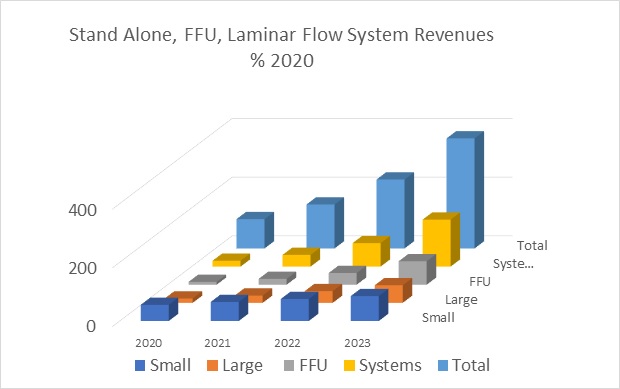
All of these products will save
lives.
However, none will have
the cost/benefit ratio of masks.
The holistic program
should therefore prioritize
mask production.
Wildfire health impairment is
steadily increasing. There is
growing evidence that trace
contaminants such as lead in the
air are more prevalent than
previously known. So even in a
city such as St Louis it will be
wise to wear a mask when the
wind is blowing from the lead
smelter. For many cities around
the world air pollution is the
cause of hundreds of thousands
of deaths. Allergies impact
millions. Many people have
sensitive lungs.
All
of these factors provide
long term demand for masks.
There will be a mix of
disposable and reusable masks.
But as shown in the daily
CATER Mask Decisions the
CATER Mask has the comfort,
attractiveness, tight fit,
efficiency and reusability which
is needed.
Since a CATER mask could be used
for 30 days or even longer it
will require much less media.
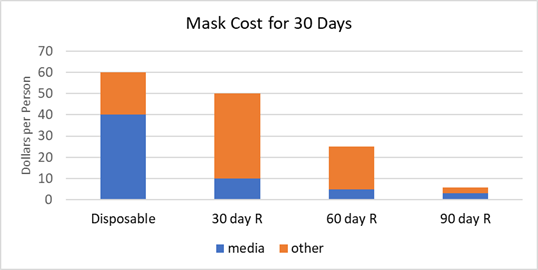
Disposable masks will use much
more media and will be less
effective. If the mask costs $2
and is used for one day the
monthly cost would be $60.
A $50 dollar CATER mask
will have an 80 percent net
efficiency or $0.63/ unit of
efficiency vs disposable masks
at 20 percent net efficiency or
$3.00/unit of efficiency.
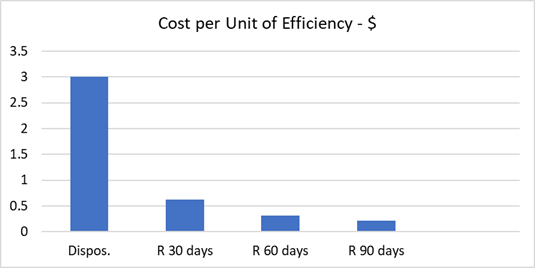
The disposable cost per unit of
efficiency is 14 times that of a
reusable mask with a 90 day
life.
The cost per unit of efficiency
of masks and filters is a
function of the viral load as
well as the filtration cost and
efficiency.
|
Source |
Treatment |
Load % |
Cost/Unit Efficiency at 100% Load |
Cost /Unit Efficiency |
|
Emitter |
Mask |
100 |
.0.63 |
0.63 |
|
Recipient |
Mask |
5 |
0.63 |
12.60 |
|
HVAC |
HEPA Filter |
1 |
0.20 |
20.00 |
|
HVAC |
HEPA Filter |
10 |
0.20 |
2.00 |
An emitter of the virus is
filtering out 100% of the load.
So the cost is only
$0.63/ unit of virus avoided. He
will also be a recipient. So
even though the cost as a
recipient is relatively high the
net combination is less than the
0.63/unit efficiency.
Upgrading an HVAC system is
likely to involve less than 1%
of the viral load generated by
the individuals in the building.
The problem is that recipients
are likely to be located so that
they are exposed prior to the
ultimate removal in the HVAC
system.
Even in an optimal
setting with very good downward
laminar flow air and exposure to
10% of the virus before it
reaches the recipient the net
unit efficiency cost is still
higher than the mask.
Air purifiers in the rooms of
people in households with
coronavirus will come close to
the unit efficiency cost of the
mask but air purifiers in
locations where there is no
known virus are less cost
effective.
A combination of masks and
vaccinations can create herd
immunity quickly. It will be a
combination of CATER, surgical
and medium efficiency cloth
masks. It will not include
inefficient cloth masks.
Because CATER masks are tight
fitting, efficient, comfortable,
and attractive they will be 93%
effective where utilized. It was
determined that only one mask
would be needed per month and
possibly only one per quarter
due to reusability. This will be
the most cost-effective option.
The following table was
presented last week in our
Alert. Since that time there has
been a change in the likely
number of people vaccinated. On
the other hand we learn that
even with a 94% effectiveness
most people will still want
protection in case they are part
of the 6%. Other vaccines with
60% effectiveness will result in
no herd immunity even with 70%
of the people vaccinated.
Therefore we still calculate
that it would be desirable to
spend $98 billion per month from
now until June and then $60
billion per month in the
subsequent quarter. This could
drop to under $10 billion per
month
by February of 2022.
|
Cater Masks Needed to Reach 70% Herd Immunity with 30 Day Life |
|
Date |
Cumulative % Vaccinated |
Add % to Reach 70 |
Mask Inefficiency |
% Needing Masks 1.075 |
People Needing Masks millions |
Monthly Production Rate millions |
Monthly Revenues $ millions at $30/mask |
|
April 2021 |
20 |
50 |
7 |
54 |
3225 |
3225 |
96,750 |
|
June 2021 |
40 |
30 |
7 |
32 |
1920 |
1920 |
57,600 |
|
Sept 2021 |
50 |
20 |
7 |
22 |
1320 |
1320 |
39,600 |
|
Dec 2021 |
60 |
10 |
7 |
11 |
660 |
660 |
19,800 |
|
Feb 2022 |
65 |
5 |
7 |
5.4 |
323 |
323 |
9,690 |
There is a very large market
potential for non COVID
applications.
|
Mask Potential in non COVID Applications - billions |
|
|||
|
|
Air Pollution Wildfires units |
Other units |
Total units |
$ billions |
|
2021 |
1 |
.5 |
1.5 |
45 |
|
2022 |
1.1 |
0.55 |
1.65 |
50 |
|
2023 |
1.3 |
0.6 |
1.9 |
57 |
The potential for the COVID
applications is much higher than
other applications through 2021
but by 2022 it will be smaller
than the other combined markets.
So if CATER mask suppliers can
capture a big share of the non
COVID market there is not much
of a peak and valley.
|
|
COVID |
Other |
Total |
|
2021 at 90 day life |
73 |
45 |
118 |
|
2022 at 90 day life |
20 |
50 |
70 |
|
2023 at 90 day life |
7 |
57 |
64 |
It is unlikely that CATER mask
suppliers can scale up to $118
billion in revenues in 2021, but
if they could capture 70% of the
market there would be no
downturn in 2022 and only a
slight reduction in 2023.
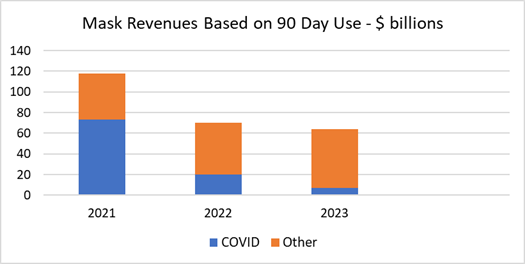
The present revenues for masks
which truly fit the CATER
criteria are only around $200
million.
This means the 2021
market potential is 600 times
larger than the present market.
The long term market is 300
times the present market.
The challenge is to persuade
people in highly polluted
cities, in an area where there
is wildfire smoke, working in
meat processing plants, or just
riding the subway that if they
are going to wear a mask it
should be a CATER mask.
It would normally be impossible
to increase revenues for a type
of product by 50 fold let alone
600 fold.
But the pandemic creates
a huge opportunity for mask
suppliers.
If they do not seize it
many thousands of people will
die. So it is not only the
profit motive which should drive
the mask suppliers.
CATER Mask Decisions
will be providing the evidence
which will show why CATER masks
are the best choice for the wide
range of applications. Mask
suppliers can take advantage of
this free service to educate
their prospects.
Face Masks will be the Focus on
Wednesday at the WFI Conference
The Conference's theme is "IAQ
Health and Safety Solutions
Associated with COVID-19",
December 15-16, 2020,
8:00 am
-12:00 pm
EST. It will address the
critical roles of facemasks and
air filtration during the
current pandemic for public
health and safety. The virtual
conference will feature the
following four sessions:
1. Emerging Challenges and
Responses
2. IAQ and the Built Environment
3. Facemask Technologies and
Latest Developments
4. Facemask/Air Filter Test
Methods and Standards
Face masks will be discussed on
Wednesday.
One of the speakers will
be Wendover Brown, Her
background is provided at
https://www.wfinstitute.com/post/fashion-in-efficient-consumer-masks
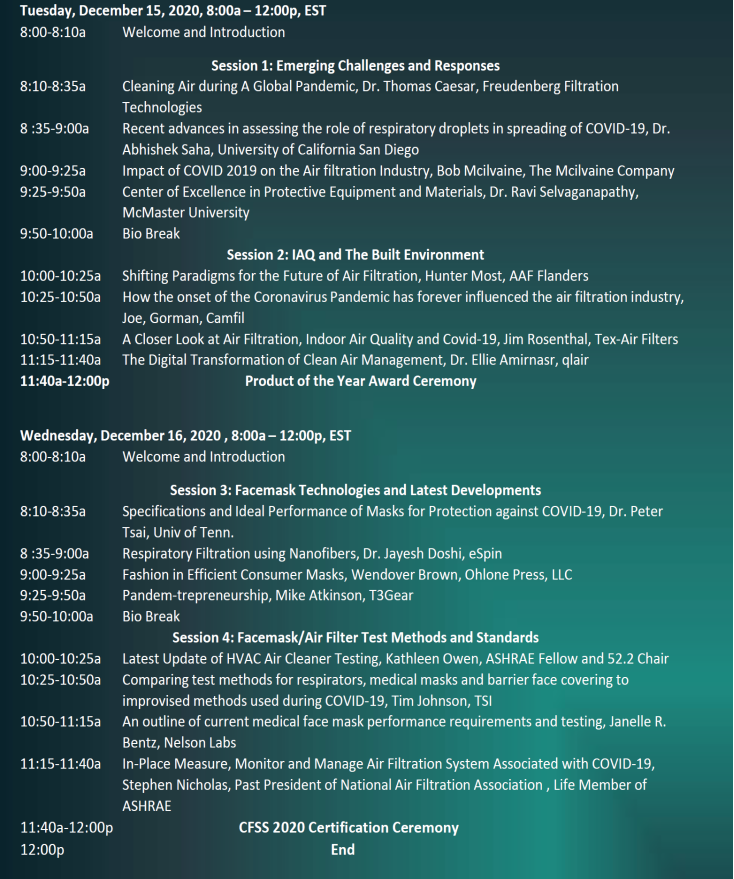
You can sign up for one or both
days at
REGISTER NOW!
Researchers at King Abdullah
University Develop Membrane for
Face Masks
N95 masks filter about 85% of
particles smaller than 300 nm,
according to published research.
SARS-CoV-2 (the coronavirus that
causes COVID-19) is in the size
range of 65–125 nm, so some
virus particles could slip
through these coverings. Also,
because of shortages, many
health care workers have had to
wear the same N95 mask
repeatedly, even though they are
intended for a single use. To
help overcome these problems,
Muhammad Mustafa Hussain and
colleagues wanted to develop a
membrane that more efficiently
filters particles the size of
SARS-CoV-2 and could be replaced
on an N95 mask after every use.
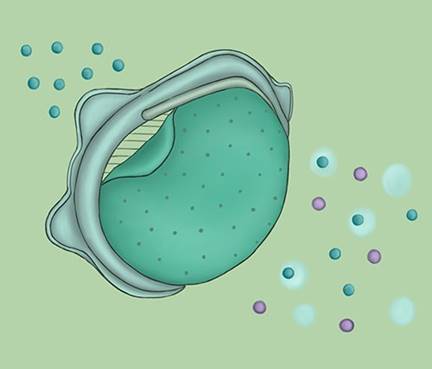
A replaceable nanoporous
membrane, illustrated above,
attached to an N95 mask filters
out particles the size of
SARS-CoV-2 (purple circles),
allowing only clean air (blue
circles) through.
Credit: ACS Nano 2020,
DOI: 10.1021/acsnano.0c0397
To make the membrane, the
researchers first developed a
silicon-based, porous template
using lithography and chemical
etching.
They placed the template over a
polyimide film and used a
process called reactive ion
etching to make pores in the
membrane, with sizes ranging
from 5-55nm.
Then, they peeled off the
membrane, which could be
attached to an N95 mask. To
ensure that the nanoporous
membrane was breathable, the
researchers measured the airflow
rate through the pores.
They found that for pores tinier
than 60nm (i.e. smaller than
SARS-CoV-2), the pores needed to
be placed a maximum of 330 nm
from each other to achieve good
breathability.
The hydrophobic membrane also
cleans itself because droplets
slide off it, preventing the
pores from getting clogged with
viruses and other particles.
https://pubs.acs.org/doi/abs/10.1021/acsnano.0c03976
TTG has Efficient Membrane Media
for Masks
TTG’s proprietary membranes have
helped guard medical personnel
and medical equipment for years.
The latest AIRADIGM™ innovation
takes health care worker and
patient protection to the next
level. Merging expertise in
filtration and membrane
engineering with experience in
performance fabric design, TTG
has created a new AIRADIGM
composite medical face mask
medium that delivers an
incomparable value equation that
includes comfort, longevity,
durability, and sustainability.
Three Layers of Protection
AIRADIGM’s composite face mask
material is a proprietary
construction that features:
-
Spun-lace
polyester on the
outside
-
ePTFE membrane
in the center
-
Spun-bond
polypropylene on
the inside
-
Three layers
sonically
laminated for
integrity and
durability
The new AIRADIGM composite
fabric TG77007 meets N95
surgical mask and ASTM Level 3
criteria for face mask media
that offer the highest levels of
protection against particulates,
microbes, and fluids. *
Comfort and Performance
Studies have shown that PPE
comfort is a must for compliance
and concentration, both of which
are absolutely critical in
healthcare settings. Just like
in performance apparel, AIRADIGM
membranes keep fluids out but
allow body heat and vapor to
escape so that the wearer stays
comfortable for the long term.
Also, the composite fabric’s
membrane core supports
breathability without
compromising protection.
This unique AIRADIGM composite
medical face mask fabric
provides filtration capabilities
that do not degrade with
humidity the way that
traditional mask materials do.
Microbe and particle protection
levels stay consistently high
for all-day protection without
frequent mask replacements.
Durable and Sustainable
In addition to protecting for
longer periods of time than
traditional face masks, masks
made with the special AIRADIGM
composite material can be
cleaned in an autoclave and
safely reused. That relieves the
stress on the PPE supply chain
and improves return on
investment, not to mention that
substantially fewer masks end up
in the landfill.
AIRADIGM membranes and composite
fabrics are manufactured by TTG
in the United States in a clean,
resource considerate,
state-of-the-art facility for
the highest quality, quickest
customer support, and most
reliable deliveries.
*Click
here for
AIRADIGM’s TG77007 composite
medical face mask material
technical specification sheet.
ePTFE Membranes - Application in
High-End Face Masks
With the recent advent of
Covid-19, there is a significant
strain on resources pertaining
to either the prevention or
containment of the virus.
One of the key shortages
highlighted has been around face
masks, where some experts have
suggested that if the pandemic
continues to wreak havoc, the US
presently has only 1% of the
face masks it would need.
This shortfall has led to
opportunistic behavior, such
that the price of face masks has
more than quadrupled in the past
three weeks. As a result, good
quality masks are not only
scarce, but are being sold at an
unimaginable premium.
Poly Fluoro Ltd
ePTFE membranes have advantages
as mask media.
While ePTFE itself is not a
low-cost material, its
application in face masks could
be revolutionary and allow for a
very effective product in
fighting the current crisis. The
reasons for this are as follows:
-
Permeability –
ePTFE has a
unique property
of being
impervious to
liquids, but
permeable to
gases. Since
Covid-19 is
known to be
spread by
droplets in the
air, ePTFE forms
an ideal medium
to arrest the
passage of
droplets
-
FDA approved –
as PTFE is an
FDA approved
material, it
poses no risks
to being used in
face masks.
Indeed, PTFE is
one of the few
materials that
is approved for
insertion into
the human body,
making it
completely safe
for such an
application
-
Hydrophobic –
not only is
ePTFE resistant
to droplets, but
it is also
hydrophobic in
nature, meaning
that droplets
that do reach it
are immediately
repelled. Hence,
there is less
risk that an
infected droplet
would remain on
the surface of
the material.
This allows the
face mask to
have a longer
lift, as there
is less chance
that the
infection stays
on the surface
of the material.
-
Low cost – as
mentioned, ePTFE
is itself an
expensive
material.
However, when
used in a small
quantity – such
as would be
needed in a face
mask – the price
is negligible
when compared
with standard
face masks
With the current crisis in play,
it is essential that newer and
more effective materials are
brought into action. ePTFE is
one such material, as it can be
manufactured in bulk and
embedded into a standard
non-woven polypropylene mask to
give a manifold improvement in
protection, while adding very
little in terms of cost.
By the company’s estimate, a
simple ePTFE lined face mask
should cost nothing more than
US$0.2 per piece – which is a
far cry from the US$2-3 we are
currently seeing for high-end
masks on the market.
Poly Fluoro Ltd
has been at the forefront of
polymer innovation, pioneering
the manufacture and application
of engineering plastics since
1985. Integrating in-house
processing techniques with
innovative machining and
fabrication capabilities, they
have developed a unique range of
products tailored to suit
numerous applications.
Poly Fluoro partners with over
100 Original Equipment
Manufacturers (OEMs), supplying
value-added products in PTFE,
PEEK, Delrin, Nylon, and a range
of other high-performance
polymers.
Over the years, the company’s
specialty products have become
synonymous with the most
reliable and robust engineering
plastics for OE fitment.
Operating out of a 20,000 square
foot plant, they are an
accredited ISO 9001 company that
offers end-to-end design,
prototype, and production
services.
The company manufacturing
facility is equipped with the
capacity to mold, extrude,
expand, and machine polymers in
sizes ranging from 10mm to 500mm
in diameter. Specializing in
both virgin and formulated
grades, they offer end-products
ideally suited for use in
original equipment and
industrial maintenance.
DHA Uses Same Media for Masks
and Gas Turbine Inlet Filters
DHA Filter has been in
industrial filtration for more
than three decades.
Like so many companies, the
Coronavirus pandemic has had a
dramatic impact on how it does
business. As a filtration media
producer, DHA began receiving
inquiries as early as January by
face mask manufacturers looking
to procure meltblown
polypropylene.
Up to this point, this has been
the preferred material for face
mask construction. As the volume
of requests rapidly increased,
it became clear that the supply
of this material was going to
fall well short of global
demand.
DHA began the search for
alternative materials that might
yield similar if not superior
filtration properties.
Immediately it became apparent
that the DHA proprietary HEPA
grade, low resistance PTFE
membrane developed for gas
turbine inlet filters would be a
viable option.
DHA reworked the membrane with
approved base support materials
to quickly enter the PPE arena.
The underlying technology is an
PTFE face mask membrane that
acts as the mask’s efficiency
layer.
It is encompassed by a layer of
spunbond polypropylene on either
side to complete the composite
used to make the masks. In lab
testing the material proved to
be 99% efficient at filtering
particles 0.1 micron and larger.
This exceeds the standard for
materials used in typical PTFE
face mask. The material is also
100% hydrophobic which aids in
creating an impenetrable barrier
against droplets and spray.
FEATURES
-
100%
Hydrophobic,
preventing
transfer of
fluids
-
Filters 99% of
particulate
matter
-
Breathable,
lightweight PTFE
membrane for
comfort
-
Spunbond support
layer resists
tearing and
shredding
-
Sonically welded
construction for
durability
-
Flexible metal
nose piece
ensures secure
fit
-
Low air
resistance
allows for
uninhibited
breathing
-
Suitable for all
day wear
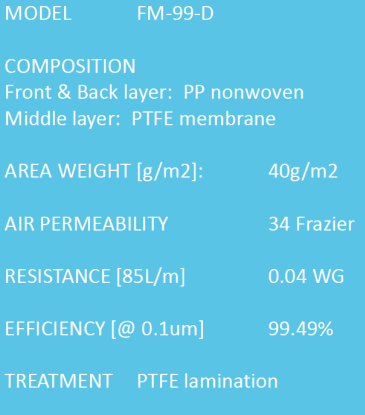
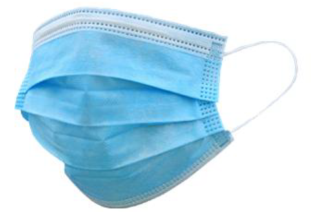
TEFM Provides ePFTE Membranes
for Masks
TEFM is made of ePTFE
microporous material by unique
nano-technology. The PTFE
membrane has a micropore
structure with small pore size,
high porosity and irregular
permutation. The efficiency for
diameter 0.3 um particulate can
be above 95%. It has excellent
performance to block PM2.5
particulate, dust mite, virus &
bacteria. The PTFE filtration
membrane with a wide
application, such as N99, N95,
KF94, FFP3 mask, medical masks
is reusable.
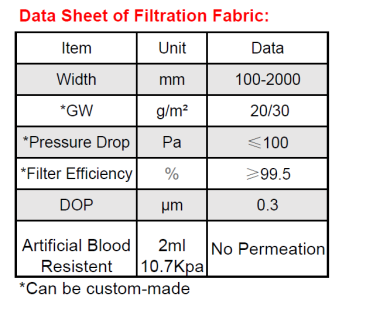

The masks retain performance
after repeated washing,
especially after laundering with
surfactants and at high
temperatures, but performance
may differ from the laboratory
tests. Hence, while
antimicrobial masks can offer
additional protection against
microbes, basic hygiene
practices such as not touching
the mask surface and washing of
hands should still be observed.
Membranes for Mask Supplied by
Cobetter
Cobetter is a Chinese company
supplying PTFE membranes for
masks. The advantages are
explained at
https://www.cobetterfiltration.com/Industries/Medical/Mask/mask-membrane-PTFE/
Founded
in 2003, Cobetter is an
international company
headquartered in Hangzhou, China
with over 1500 employees and
nearly 100,000 square feet of
filtration production area
cleanroom space. With over 1,200
products and 100-patented
technologies, Cobetter has
developed a full product range
composed of core materials with
unique performance capabilities.
Cobetter has implemented
extensive quality control
methods throughout their entire
manufacturing process for their
filtration products. These
measures ensure the products are
high quality, stable, and
reliable in accordance with ISO
9001, 13485, 14001, and OHSAS
18001 standards. One of
Cobetter’s core competencies is
their membrane technology which
they develop and manufacture
in-house.
The Cobetter representative in
the U.S. and Singapore is Banner
Industries. It was founded in
1985 to serve a rapidly
expanding high purity market and
to satisfy the increasing demand
for high-quality components with
fast delivery at competitive
prices.
BYU Develops Nanofiber Mask
The cloth masks many are
sporting these days offer some
protection against COVID-19.
However, they typically provide
much less than the professional
N95 masks used by healthcare
workers.
That may soon change. Recently,
students from BYU’s College of
Engineering teamed up with Nanos
Foundation to
develop a nanofiber membrane
that can be sandwiched between
the cloth pieces in a homemade
mask.
While today’s typical cloth mask
might block fewer than 50% of
virus particles, the membrane —
which can be made using simple,
inexpensive materials — will be
able to block 90 to 99% of
particles, increasing
effectiveness while preserving
breathability.
The membranes are made through a
process called “electrospinning,”
which involves dissolving a
polymer plastic in a solution
and then using an electrical
current to move a droplet of the
polymer downward through a
needle. As the droplet
accelerates, it stretches into a
very small fiber that retains a
static charge.
“Those nanofibers randomly land
on a collector to create a sort
of non-woven mesh,” said Katie
Varela, a BYU mechanical
engineering senior on the
project team.
The remaining charge in the
fibers is beneficial, she
explained, because virus
particles also have a static
charge. “When they come close to
your mask, they will be
statically attracted to the mask
and will not be able to go
through it, and so it prevents
you from inhaling viruses.”
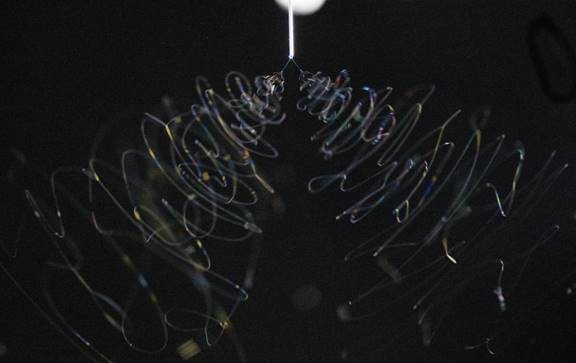
Liquid polymer is stretched out
to create nanofibers used to
increase the efficiency of cloth
masks.
In addition to the dramatic
improvement in efficacy, another
key benefit of the nanofiber
masks is that unlike traditional
N95 masks, which have a
reputation for being hot and
stuffy, they allow for the
circulation of (filtered) air,
water, and heat.
“Not only is it hard to find an
N95 mask these days, but the
best mask is useless if you
won’t wear it,” said Will Vahle,
director at Nanos Foundation.
“Our nanofiber membranes are six
times easier to breathe through
than existing N95 masks, making
them cooler, drier, and more
comfortable.”
The group plans to make the
instructions for creating the
membranes open source. They hope
that non-profit organizations
will use the instructions to set
up local sites where people can
bring in their masks to be
fitted with a membrane. They
also hope other engineers will
use their work as a springboard
to produce more effective
filters.
“We had our own proprietary
nanofiber production process,”
said Vahle of the project’s
origins, “but we realized, hey,
we have some expertise in this —
why don’t we get this together
and release a version that
anybody can do?”
When Vahle and his colleagues
approached BYU to collaborate on
the project, BYU “jumped at the
opportunity,” Vahle said. In
addition to providing funding
and facilities, the university
connected the company with
“fantastic students, who’ve
really demonstrated an
incredible work ethic and a
drive to help people in need.”
Using cutting-edge science to
make an immediate positive
impact has also been highly
valuable for the BYU students on
the project.
“This experience makes things
very real,” said Varela. “I’m
really glad that I’m able to
help with this fight against
COVID-19 to help people all
around the world and in my
community.”
Nanofiber Media Reduces Face
Mask Resistance
This was the conclusion of
researchers from Stony Brook
University
Potentially infected individuals
(‘source’) are sometimes
encouraged to use face masks to
reduce exposure of their
infectious aerosols to others
(‘receiver’). To improve
compliance with Respiratory
Source Control via face mask and
therefore reduce receiver
exposure, a mask should be
comfortable and effective. the
researchers tested a novel face
mask designed to improve
breathability and filtration
using nanofiber filtration.
Using radiolabeled test aerosols
and a calibrated exposure
chamber simulating source to
receiver interaction, facepiece
function was measured with a
life-like ventilated manikin
model. Measurements included
mask airflow resistance
(pressure difference during
breathing), filtration, (mask
capture of exhaled radiolabeled
test aerosols), and exposure
(the transfer of ‘infectious’
aerosols from the ‘source’ to a
‘receiver’). Polydisperse
aerosols were measured at the
source with a mass median
aerodynamic diameter of 0.95 µm.
Approximately 90% of the
particles were <2.0 µm. Tested
facepieces included nanofiber
prototype surgical masks,
conventional surgical masks, and
for comparison, an N95-class
filtering facepiece respirator
(commonly known as an ‘N95
respirator’). Airflow through
and around conventional surgical
face mask and nanofiber
prototype face mask was
visualized using Schlieren
optical imaging.
Airflow resistance [ΔP, cmH2O]
across sealed surgical masks
(means: 0.1865 and 0.1791 cmH2O)
approached that of the N95
(mean: 0.2664 cmH2O).
The airflow resistance across
the nanofiber face mask whether
sealed or not sealed (0.0504 and
0.0311 cmH2O) was
significantly reduced in
comparison. In addition,
‘infected’ source airflow
filtration and receiver exposure
levels for nanofiber face masks
placed on the source were
comparable to that achieved with
N95 placed on the source; 98.98%
versus 82.68% and 0.0194 versus
0.0557, respectively. Compared
to deflection within and around
the conventional face masks,
Schlieren optical imaging
demonstrated enhanced airflow
through the nanofiber mask
Substituting nanofiber for
conventional filter media
significantly reduced face mask
airflow resistance directing
more airflow through the face
mask resulting in enhanced
filtration. Respiratory source
control efficacy similar to that
achieved through the use of an
N95 respirator worn by the
source and decreased airflow
resistance using nanofiber masks
may improve compliance and
reduce receiver exposure.
https://www.ncbi.nlm.nih.gov/pmc/articles/PMC4090760/
Properties of commercially
available antimicrobial masks.
Compared.
Anti-microbial masks were
compared in a study linked
below. Here is a summary.
|
Mask Brand |
Classificationa |
Antimicrobial in outer layer |
Antimicrobial in inner layer |
Mask proven biocidal against |
|
Nexera Medical SpectraShieldTM |
N95 (ONT) |
Ag-Cu zeolite |
X |
Bacteria; virus |
|
GlaxoSmithKline Actiprotect® |
N95 (ONT) |
Citric acid |
X |
Virus |
|
Filigent BioFriendTM BiomaskTM |
N95 (ONT) |
Citric acid |
Cu NPs |
Virus |
|
Innonix RespoKareTM |
Surgical (OUK) |
Citric acid |
Cu NPs |
Virus |
|
NBC Meshtec Cufitec® |
Surgical (OUK) |
CuI NPs |
X |
Virus |
|
Anson Nano Silver |
Surgical |
X |
AgNPs |
Bacteria; fungi |
|
Copper Clothing |
Washable KN99 (FFP3) |
CuxO NPs |
X |
Bacteria; virus; fungib |
|
Cupron Inc. |
Washable |
CuxO NPs |
X |
Bacteria; virus; fungi b |
|
Copperline |
Washablec |
CuxO NPs |
X |
Bacteria |
|
Argaman BioBlockXTM |
Reusabled |
Cu2O NPs |
Cu2O NPs |
Bacteria; virus |
|
Sonovia SonomaskTM |
Washable |
X |
ZnO NPs |
Bacteria |
aMedical
and/or FDA classification.
OUK = FDA clearance as a
surgical mask with
antimicrobial/antiviral agent;
ONT = FDA clearance as an N95
mask with
antimicrobial/antiviral agent.
Washable/reusable masks do not
require any certification. bAntimicrobial
tests were performed only on
fabric but not directly on the
masks. cSingle HEPA
filter provided with the mask is
not washable or reusable. dReusable
but not recommended to be
laundered.
